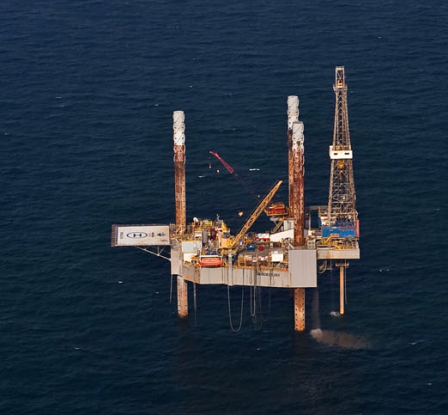Oil and Gas Extraction Effluent Guidelines
 EPA promulgated the Oil and Gas Extraction Effluent Guidelines and Standards (40 CFR Part 435) in 1979, and amended the regulations in 1993, 1996, 2001 and 2016. The regulations cover wastewater discharges from field exploration, drilling, production, well treatment and well completion activities. These activities take place on land, in coastal areas and offshore.
EPA promulgated the Oil and Gas Extraction Effluent Guidelines and Standards (40 CFR Part 435) in 1979, and amended the regulations in 1993, 1996, 2001 and 2016. The regulations cover wastewater discharges from field exploration, drilling, production, well treatment and well completion activities. These activities take place on land, in coastal areas and offshore.On this page:
- What is the Oil and Gas Extraction Industry?
- Facilities Covered
- Unconventional Extraction - Pretreatment Standards
- Study of Oil and Gas Extraction Wastewater Management - 2019
- Coalbed Methane Extraction
- Rulemaking History
- Additional Information
What is the Oil and Gas Extraction Industry?
Oil and Gas Extraction is the exploration and production of petroleum and natural gas from wells. The industry generates wastewater from the water extracted from the geological formations and from chemicals used during exploration, well drilling and production of oil and gas.
These activities are included within NAICS code 211111, Crude Petroleum and Natural Gas Extraction. (Note: the NAICS group listings are provided as a guide and do not define the coverage of the Oil and Gas regulations. For precise definitions of coverage, see the applicability sections in 40 CFR Part 435.)
Facilities Covered
-
Offshore
-
Onshore
-
Coastal
-
Agricultural and Wildlife Water Use
-
Stripper Wells
| All Subparts | Subparts A & D Only |
|---|---|
| produced water |
Domestic |
| Produced sand | Sanitary |
| Drilling fluids | Deck drainage |
| Drill cuttings | |
| Well treatment, workover & completion fluids |
Unconventional Extraction - Pretreatment Standards
- Final Rule (June 2016)
Study of Oil and Gas Extraction Wastewater Management - 2019
Coalbed Methane Extraction Documents - 2010/2013
Rulemaking History
2016 Amendment
- Subpart C - Final Rule (June 2016)
2001 Amendment
- Clarification Memo: Standards for Controlling SBF Discharges (10/10/2003)
- Technical correction to January 22, 2001 rule (June 8, 2001)
- Final Rule (January 22, 2001)
- Development Document
Describes industry processes, pollutants generated, available control & treatment technologies, the technical basis for the final rule, and costs of the rule
- Development Document
- Proposed Rule (February 3, 1999)
1996 Amendment
- Final Rule (December 16, 1996)
- Proposed Rule (February 17, 1995)
1993 Amendment
- Documents, including:
- Final Rule (March 4, 1993)
- Development Document
- Proposed Rules:
- March 13, 1991
- November 26, 1990
- October 21, 1988 (Notice of Data Availability)
- August 26, 1985
- Final Rule (March 4, 1993)
1979 Initial Rulemaking
- Documents, including:
- Final Rule (April 13, 1979)
- Interim Final Rules:
- October 13, 1976 (Subparts C through F)
- September 15, 1975 (Subparts A and B)
- Development Document
Additional Information
For additional information on Oil and Gas Effluent Guidelines, please contact Jesse Pritts (pritts.jesse@epa.gov) or 202-566-1038.
